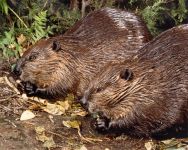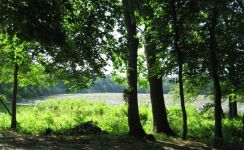


|

|
|
 
|

By now, most of you will be aware that we are moving forward with our plans to replace our dilapidated headquarters building (our 'cabin') with a new building that will be more efficient and hospitable for our onsite manager. Our headquarters is located at the major access point for the Refuge and close to the main pond. Not only is it crucial to the administration and protection of the Refuge, it provides living space for the onsite manager, the person indispensable in maintaining and protecting the Refuge. As you can see from the photo, the view from the office is compelling. Once the new building is ready for occupation, the Miller House, a short distance away, will become an expanded education and volunteer center.
Since sending out the appeal for funds for the new building, we have received many generous donations. Thank you to everyone who has donated so far. Through their generosity, we have reduced the projected need for the project from $175,000 to $165,000. We hope that those of you who have not yet made a contribution will do so to help us reduce this even further!
We -- and the wildlife -- are grateful for your continued support.